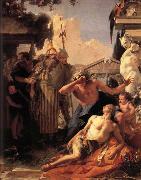Wholesale Oil Painting No Minimum |
|||||||||||
|
|
|||||||||||

|
|||||||||||
|
|
|
||||||||
Giambattista Tiepolo1696-1770 Italian painter, master of Venetian school. Tiepolo was famous in his own lifetime as a superb painter in fresco and a brilliant draftsman. A highly inventive artist, he could create spectacular effects in difficult sites, from the narrow gallery at the patriarchal palace at Udine in the mid-1720s to the vast staircase ceiling in the Residenz at Werzburg in the early 1750s. Contemporaries recognized his spirited, dynamic approach to subject matter and his frankly sensuous manner of painting. Tiepolo is comparable in his restless energy and imaginative power to Peter Paul Rubens, and essentially he worked with a similar baroque language of myth, allegory, and history, which he infused with a sense of freshness and modernity. His approach to religious art is characterized by candor and naturalism, while he was responsive to the different concerns of patrons and viewers at a time when the church was faced with new kinds of devotion and criticism. With the advent of neoclassicism, Tiepolo's art fell from favor: In an age that prized archaeological correctness, rationality, and ideals of improvement, his witty, Veronese-inspired conception of historical or classical subjects seemed frivolous, while his visually seductive qualities were seen as inimical to the serious intellectual aims of the new art. Nevertheless, his drawings and oil sketches continued to appeal to collectors, including Antonio Canova. The son of a Venetian shipping merchant, Tiepolo was apprenticed in 1710 to Gregorio Lazzarini (1655C1730), an artist of international reputation patronized by prominent Venetian families. Before becoming an independent master, he worked in the household of Doge Giovanni Corner; members of the Corner family were to be his most steadfast and liberal patrons. Lazzarini encouraged his pupils to study Venetian sixteenth-century art, and Tiepolo made drawings of some famous works for publication in Domenico Lovisa's Gran Teatro di Venezia of 1717. His early involvement with the thriving Venetian engraving and publishing world was renewed in 1724 when he made drawings of antique sculpture as illustrations for Scipione Maffei's Verona Illustrata, an experience that gave Tiepolo an imaginative empathy with fragmentary antique remains, which recur in his drawings, etchings, and paintings. As well as studying the art of the past, Tiepolo looked to the tenebrism of Federico Bencovich (1677C1753) and the realism and monumentality of Giovanni Battista Piazzetta (1682C1754). In 1719 Tiepolo married Cecilia Guardi, with whom he was to have nine children. By then, the artist was working for a network of mercantile and noble patrons on religious and secular subjects. |
||||||||
|
|
||||||||
The Death of Hyacinthus
The Death of Hyacinthus Painting ID:: 30292 |
nn05
1752-1753
Tennis with Apollo
nn05 1752-1753 Tennis with Apollo |
|||||||
|
|
||||||||
|
Giovanni Battista Tiepolo Italian Rococo Era Painter, 1696-1770 Giovanni Battista Tiepolo was born in Venice on March 5, 1696. His father, who was part owner of a ship, died when Tiepolo was scarcely a year old, but the family was left in comfortable circumstances. As a youth, he was apprenticed to Gregorio Lazzarini, a mediocre but fashionable painter known for his elaborately theatrical, rather grandiose compositions. Tiepolo soon evolved a more spirited style of his own. By the time he was 20, he had exhibited his work independently, and won plaudits, at an exhibition held at the church of S. Rocco. The next year he became a member of the Fraglia, or painters guild. In 1719 he married Cecilia Guardi, whose brother Francesco was to become famous as a painter of the Venetian scene. They had nine children, among them Giovanni Domenico and Lorenzo Baldassare, who were also painters. In the 1720s Tiepolo carried out many large-scale commissions on the northern Italian mainland. Of these the most important is the cycle of Old Testament scenes done for the patriarch of Aquileia, Daniele Dolfin, in the new Archbishop Palace at Udine. Here Tiepolo abandoned the dark hues that had characterized his early style and turned instead to the bright, sparkling colors that were to make him famous. The Death of Hyacinthus Date ca. 1752-1753 Medium Oil on canvas Dimensions 287 x 232 cm (113 x 91.3 in) cjr |
||||||||
|
|
||||||||
|
Prev Next
|
||||||||
|
|
||||||||
|
Related Paintings to Giovanni Battista Tiepolo :. |
||||||||
|
|
||||||||
|
CONTACT US |

